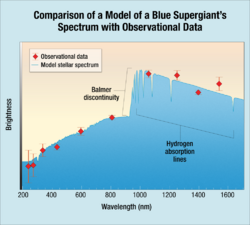Astronomy:Balmer jump
The Balmer jump, Balmer discontinuity, or Balmer break is the difference of intensity of the stellar continuum spectrum on either side of the limit of the Balmer series of hydrogen, at approximately 364.5 nm. It is caused by electrons being completely ionized directly from the second energy level of a hydrogen atom (bound-free absorption), which creates a continuum absorption at wavelengths shorter than 364.5 nm.[1]
In some cases the Balmer discontinuity can show continuum emission, usually when the Balmer lines themselves are strongly in emission.[2][3] Other hydrogen spectral series also show bound-free absorption and hence a continuum discontinuity, but the Balmer jump in the near UV has been the most observed.[4][5]
The strength of the continuum absorption, and hence the size of the Balmer jump, depends on temperature and density in the region responsible for the absorption. At cooler stellar temperatures, the density most strongly affects the strength of the discontinuity and this can be used to classify stars on the basis of their surface gravity and hence luminosity.[6] This effect is strongest in A class stars, but in hotter stars temperature has a much larger effect on the Balmer jump than surface gravity.[2][7]
See also
References
- ↑ Mihalas, Dimitri (1967). "Statistical-Equilibrium Model Atmospheres for Early-Type Stars. I. Hydrogen Continua". Astrophysical Journal 149: 169. doi:10.1086/149239. Bibcode: 1967ApJ...149..169M.
- ↑ 2.0 2.1 Slettebak, A.; Stock, J. (1957). "Classification of Early Type Stars of High Luminosity with Objective Prism Spectra of Low Dispersion. With 7 figures". Zeitschrift für Astrophysik 42: 67. Bibcode: 1957ZA.....42...67S.
- ↑ Knigge, Christian; Long, Knox S.; Wade, Richard A.; Baptista, Raymundo; Horne, Keith; Hubeny, Ivan; Rutten, Rene G. M. (1998). "Hubble Space Telescope Eclipse Observations of the Nova‐like Cataclysmic Variable UX Ursae Majoris". The Astrophysical Journal 499 (1): 414–428. doi:10.1086/305617. Bibcode: 1998ApJ...499..414K.
- ↑ Liu, X.-W.; Danziger, J. (1993). "Electron temperature determination from nebular continuum emission in planetary nebulae and the importance of temperature fluctuations". Monthly Notices of the Royal Astronomical Society 263: 256–266. doi:10.1093/mnras/263.1.256. Bibcode: 1993MNRAS.263..256L.
- ↑ Scargle, J. D.; Erickson, E. F.; Witteborn, F. C.; Strecker, D. W. (1978). "Infrared excesses in early-type stars - Gamma Cassiopeiae". Astrophysical Journal 224: 527. doi:10.1086/156400. Bibcode: 1978ApJ...224..527S.
- ↑ Bessell, Michael S. (2007). "Measuring the Balmer Jump and the Effective Gravity in FGK Stars". Publications of the Astronomical Society of the Pacific 119 (856): 605–615. doi:10.1086/519981. Bibcode: 2007PASP..119..605B.
- ↑ Crowther, P. A. (1997). "The effective temperatures of hot stars". International Astronomical Union Symposium 189: 137–146. doi:10.1017/S0074180900116614. Bibcode: 1997IAUS..189..137C.
 |



